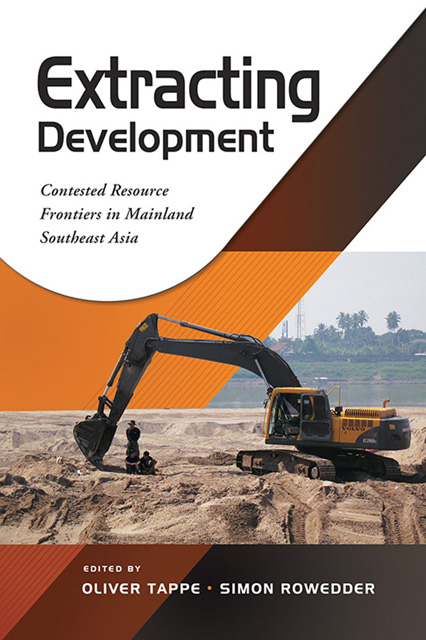Book contents
- Frontmatter
- Contents
- Acknowledgements
- The Contributors
- 1 Contested Resource Frontiers in Mainland Southeast Asia: An Introduction
- 2 Ontological Politics of the Resource Frontier: A Hydrosocial Analysis of the Mekong River in Northern Thailand
- 3 Reassembling Frontiers for Middle-Income Peasants: Rubber Expansion and Livelihood Ecosystem Transformation in a Northeast Thai Village
- 4 “Only the Best Fruits for China!”: Local Productions of a ‘Fruit Frontier’ in the Borderlands of China, Laos and Thailand
- 5 Commodity Frontiers in Motion: Tracing the Maize Boom across the Lao-Vietnamese Borderlands
- 6 New Frontier Spaces: Complex Entanglements and Power Relations (Re)shaping Land Governance in Laos
- 7 Moving Away from the Margins? How a Chinese Hydropower Project Made a Lao Community Modern and Comfortable
- 8 Frontier Capitalism in Colonial and Contemporary Laos: The Case of Tin Mining
- 9 Chinese Investments and Resource Frontiers in Cambodia: Systemic Transformation
- 10 The Open Issues: Cases between Chinese Investment Companies and Local People in Myanmar
- 11 Internationalization of RMB and Tin Ore Trade in China-Myanmar Frontier Governance: Views from Yunnan Province
- Index
9 - Chinese Investments and Resource Frontiers in Cambodia: Systemic Transformation
Published online by Cambridge University Press: 30 June 2023
- Frontmatter
- Contents
- Acknowledgements
- The Contributors
- 1 Contested Resource Frontiers in Mainland Southeast Asia: An Introduction
- 2 Ontological Politics of the Resource Frontier: A Hydrosocial Analysis of the Mekong River in Northern Thailand
- 3 Reassembling Frontiers for Middle-Income Peasants: Rubber Expansion and Livelihood Ecosystem Transformation in a Northeast Thai Village
- 4 “Only the Best Fruits for China!”: Local Productions of a ‘Fruit Frontier’ in the Borderlands of China, Laos and Thailand
- 5 Commodity Frontiers in Motion: Tracing the Maize Boom across the Lao-Vietnamese Borderlands
- 6 New Frontier Spaces: Complex Entanglements and Power Relations (Re)shaping Land Governance in Laos
- 7 Moving Away from the Margins? How a Chinese Hydropower Project Made a Lao Community Modern and Comfortable
- 8 Frontier Capitalism in Colonial and Contemporary Laos: The Case of Tin Mining
- 9 Chinese Investments and Resource Frontiers in Cambodia: Systemic Transformation
- 10 The Open Issues: Cases between Chinese Investment Companies and Local People in Myanmar
- 11 Internationalization of RMB and Tin Ore Trade in China-Myanmar Frontier Governance: Views from Yunnan Province
- Index
Summary
INTRODUCTION
China's overseas investments have significantly shaped resource frontiers in Cambodia. Resource frontiers here refer to “spaces of capitalist transition, where new forms of social property relations and systems of legality are rapidly established in response to market imperatives” (Barney 2009, p. 146). Exploiting new frontiers of land and natural resources are the key sources of economic development. The process of economic development is not just about allocating scarce resources but also about obtaining and developing new frontiers of natural resources. In this connection, “frontier-based development is the process of exploiting or converting new sources of relatively abundant resources for production purposes” (Barbier 2011, p. 7). Extractive and productive transformations are the makings of new Asian resource frontiers called “frontier assemblages”, referring to “the intertwined materialities, actors, cultural logics, spatial dynamics, ecologies, and political-economic processes that produce particular places as resource frontiers” (Cons and Eilenberg 2019, p. 2).
Systemic transformation is defined as the drastic changes in social, economic, natural, political and governance landscapes. This chapter provides an initial qualitative assessment of the impacts of Chinese investments on systemic transformation in Cambodia. The chapter has three main sections, namely, enabling factors, perceived impacts of the Chinese investments, and local governance issues. Sihanoukville is used as a case study to demonstrate the impacts of Chinese investments on local governance. It argues that the influx of Chinese investments to Cambodia—in both extractive and productive sectors—over the past decade has shaped resource frontiers in many ways as they generate cross-sectoral impacts on the Cambodian economy, society, environment, politics and governance. Agriculture, manufacturing, infrastructure and tourism are the main investment sectors. While Chinese investments present huge material opportunities, they also disrupt local livelihoods and the environment and transform local governance at varying speeds and magnitude.
ENABLING FACTORS
Foreign direct investment (FDI) plays a critical role in socio-economic development in Cambodia. Peace, macroeconomic stability, political predictability, resource endowment, relatively cheap labour forces, and gradual improvement of investment climate together with governance reforms and gradual economic diversification have enabled Cambodia to attract foreign investments. For instance, at the Government–Private Sector Forum held in Phnom Penh in March 2019, the government laid out new commitments and concrete reforms to reduce the cost of production and logistics (Chheang 2019).
- Type
- Chapter
- Information
- Extracting DevelopmentContested Resource Frontiers in Mainland Southeast Asia, pp. 198 - 220Publisher: ISEAS–Yusof Ishak InstitutePrint publication year: 2022

